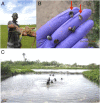Reduced transmission of human schistosomiasis after restoration of a native river prawn that preys on the snail intermediate host
- PMID: 26195752
- PMCID: PMC4534245
- DOI: 10.1073/pnas.1502651112
Reduced transmission of human schistosomiasis after restoration of a native river prawn that preys on the snail intermediate host
Erratum in
-
Correction for Sokolow et al., Reduced transmission of human schistosomiasis after restoration of a native river prawn that preys on the snail intermediate host.Proc Natl Acad Sci U S A. 2017 Aug 15;114(33):E7028-E7029. doi: 10.1073/pnas.1712011114. Epub 2017 Aug 7. Proc Natl Acad Sci U S A. 2017. PMID: 28784787 Free PMC article. No abstract available.
Abstract
Eliminating human parasitic disease often requires interrupting complex transmission pathways. Even when drugs to treat people are available, disease control can be difficult if the parasite can persist in nonhuman hosts. Here, we show that restoration of a natural predator of a parasite's intermediate hosts may enhance drug-based schistosomiasis control. Our study site was the Senegal River Basin, where villagers suffered a massive outbreak and persistent epidemic after the 1986 completion of the Diama Dam. The dam blocked the annual migration of native river prawns (Macrobrachium vollenhoveni) that are voracious predators of the snail intermediate hosts for schistosomiasis. We tested schistosomiasis control by reintroduced river prawns in a before-after-control-impact field experiment that tracked parasitism in snails and people at two matched villages after prawns were stocked at one village's river access point. The abundance of infected snails was 80% lower at that village, presumably because prawn predation reduced the abundance and average life span of latently infected snails. As expected from a reduction in infected snails, human schistosomiasis prevalence was 18 ± 5% lower and egg burden was 50 ± 8% lower at the prawn-stocking village compared with the control village. In a mathematical model of the system, stocking prawns, coupled with infrequent mass drug treatment, eliminates schistosomiasis from high-transmission sites. We conclude that restoring river prawns could be a novel contribution to controlling, or eliminating, schistosomiasis.
Keywords: control; disease; ecology; elimination; neglected tropical disease.
Conflict of interest statement
The authors declare no conflict of interest.
Figures





References
-
- WHO (2015) Preventive Chemotherapy and Transmission Control (PCT) databank. Available at www.who.int/neglected_diseases/preventive_chemotherapy/databank/en/. Accessed June 15, 2014.
-
- WHO . Schistosomiasis: Progress Report 2001-2011 and Strategic Plan 2012-2020. WHO; Geneva: 2011.
-
- Gray DJ, et al. Schistosomiasis elimination: Lessons from the past guide the future. Lancet Infect Dis. 2010;10(10):733–736. - PubMed
Publication types
MeSH terms
Grants and funding
LinkOut - more resources
Full Text Sources
Other Literature Sources
Research Materials

